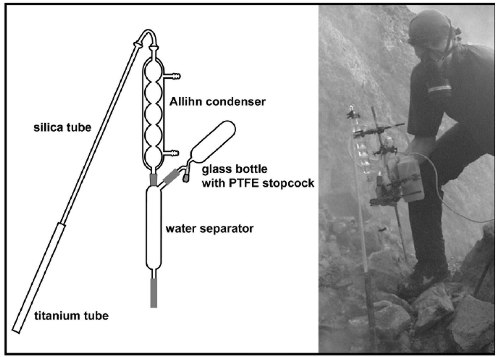 Web Content Anzeige Web Content Anzeige
Overview Theme C3Subproject C3 concerns the fluxes of volatiles from permanently degassing volcanoes, their role for atmospheric loading and climate, and for volcanic hazards and environmental impact. The concept is a) to investigate the depth and pre-eruptive fluid compositions of shallow magma reservoirs from historic eruptions of the permanently degassing volcanoes, b) determine the fluid compositions emanating from fumaroles of the same volcanoes, and c) to measure overall fluxes of volatiles into the atmosphere by fumarolic and permanent vent degassing. During the first phase of the SFB 574 we have performed both direct sampling of fumaroles and remote sensing SO2 flux analysis with the novel mini-DOAS UV spectrometer method in parallel over the last three field seasons. Fluxes of all elements other than sulfur are calculated by ratioing with sulfur, which is measured with both mini-DOAS and in the fumarolic fluids. The five permanently degassing Nicaraguan volcanoes San Cristóbal, Telica, Cerro Negro, Momotombo and Mombacho were selected for detailed studies. Preliminary data on SO2 fluxes into the atmosphere from quiescent degassing of the Nicaraguan subduction zone segment suggest about 1500 metric tonnes per day, or 3*108 kg/yr. The most active fumaroles from the volcanoes Cerro Negro, Momotombo and Mombacho were repeatedly sampled during three to four field seasons in 2002 and 2003, and the Costa Rican volcano Poas was sampled once. The main incondensable species (N2, O2, CO, H2, CH4, Ar, He, Ne), light hydrocarbons, the acid species dissolved into the alkaline solution (CO2, SO2, H2S, S, HCl, HF, HBr), and the fraction of H2O were sampled. Analyses will be completed by the end of the year. We further took around 100 special trace gas samples from a total of 18 fumaroles. The range of detectable halogenated compounds in volcanic gas samples includes methyl halides, short-chain halohydrocarbons and halogenated aromatics and heterocycles. Our special interest focuses on halomethanes and -ethanes because such C1 and C2 compounds exhibit much higher atmospheric lifetimes than longer-chain compounds, due to their negligible water solubility that prevents quantitative tropospheric washout.
Figure 1: Set-up for trace gas sampling. For manpower reasons, we chose to focus on the volcano/atmosphere interface during the first SFB phase. A pilot study on the petrology and degassing behaviour of the two youngest eruptions of Cerro Negro volcano (1995 and 1999), has, however, been completed. S/Cl ratios found in melt inclusions at Cerro Negro are close to those typically found by OP-FTIR remote sensing in the volcanic plume of Masaya volcano. This leaves the comparison between plume compositions and fluids in the magma chamber realistic. The Cerro Negro magmatic plumbing system includes two fractionation levels, at 3 and 8 km depth. |
 Events Events
Kieler Wissenschaftler fühlen den 'Puls der Erde' Wie funktioniert die Recyclingmaschine der Erde?Nach elf Jahren endet der Kieler Sonderforschungsbereich 574 zu Subduktionszonen Final colloquium of SFB 574 Teilprojekt ÖffentlichkeitsarbeitMEERESFORSCHUNG FÜR MICH UND DICH |
|
©SFB574 // Wischhofstrasse 1-3 // D-24148 Kiel // T. +49 (0)431 600 1413 // elange [AT] geomar.de






